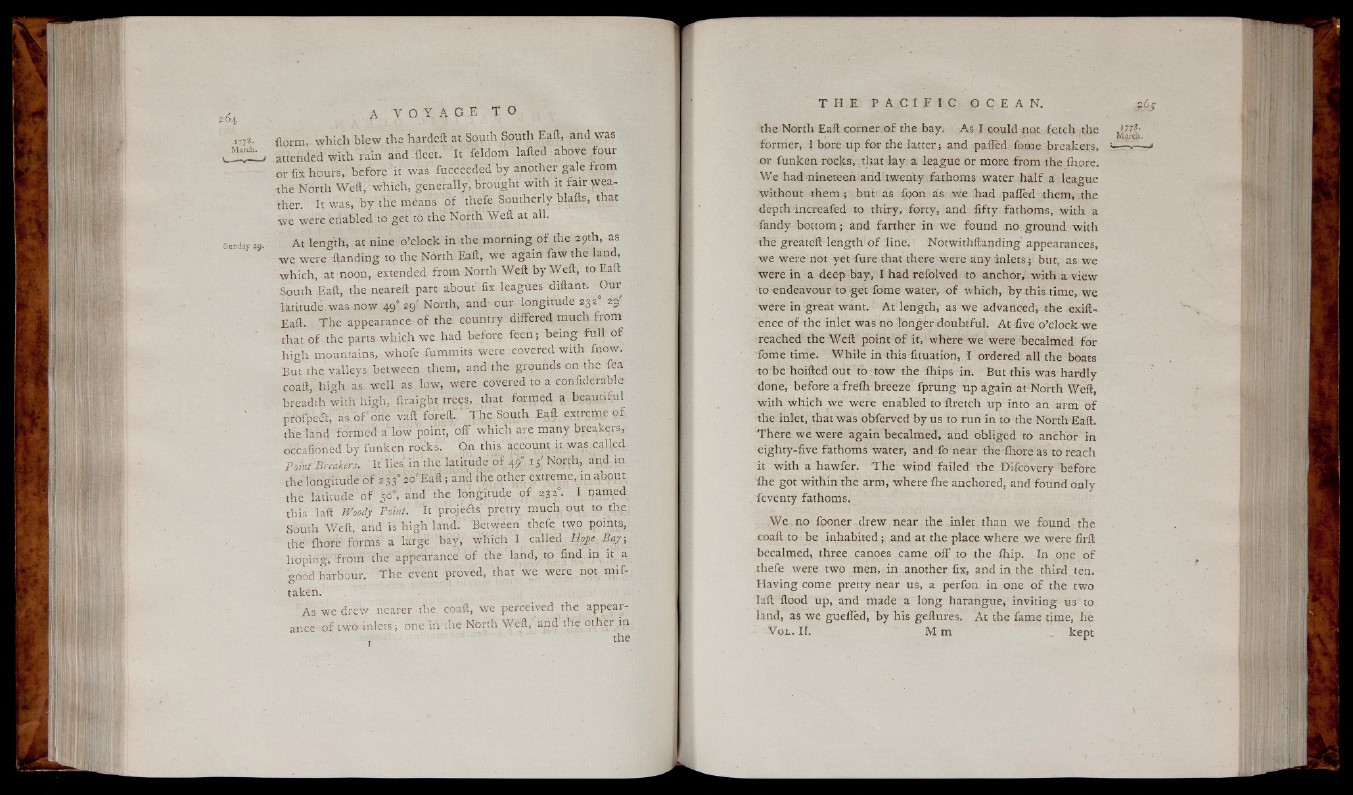
1778- ftorm, which b lew the hardeft at South South Eaft, and was
, attended w ith rain and-fleet.’ It feldom lafted above ;fou r
or fix hours, before it was fucceeded by another gale from
the North Weft, w hich, generally, brought with it fair weather.
It was, by the means o f thefe Southerly blafts, that
w e were enabled to ge t to the North Weft at all.
Sunday a9 At length, at nine o ’clock in the morning o f the 29th, as
w e were ftanding to the North Eaft, w e again faw the land,
which, at noon, extended from North Weft by W eft, to Eaft
South Eaft, the neareft part about fix leagues diftant. Our
latitude was now 49° ?g' North, and- our longitude 232 29
Eaft. T h e appearance o f the country differed much from
that o f the parts w h ich we had before feeri j be in g fu ll o f
h ig h mountains, whofe fummits were covered with fnow.
But the valleys between them, and the grounds on the fea
coaft, high as w e ll as low, were covered to a confiderable
breadth with high, ftraig\u trees, that formed a beautiful
profpeff, as o f : one va ft foreft. T h e South Eaft extreme o f
rhe land formed a low point, o f f'w h ic h are many breakers,
octafioned by funken rocks.’ On this account it was called
P o in t Breakers; It lies in the latitude o f 49° 15' North, and- in
the longitude o f 233° 20' Eaft ; and the other extreme, in about
the latitude o f 56% tind the longitude o f 2320. I named
this laft Woody Point. It proj e fts 'p re tty much ou.t to tjie,
South Weft, and is h ig h land. Between thefe two points,
the ihore forms a large 'bay, w h ich I. called | | J | _ :
hoping, from the appearance o f the land, to find in it. a
good harbour. T h e event proved, that w e were nop m is taken.
As we drew nearer the coaft, we perceived the appearance
o f two inlets; one in the North Weft, and the: other.in
j ' ' 1,1 the
the North Eaft corner o f the bay. As I could . "■ * "n■ ot fe tch t he jMylarlobh,
former, I bore up fo r the latter; and palled fome breakers,
or funken rocks, that la y a lea gu e or more from the ihore.
We had nineteen and twenty fathoms water h a lf a league
without them ; b u r as fpon as we had palled them, the
depth increafed to thiry, forty, and fifty fathoms, with a
fandy bo ttom ; and farther in we found no ground w ith
the greateft length o f line. Notwithftanding appearances,
w e were not yet fure that there were any inlets ; but, as we
were in a deep bay, I had refolved to anchor, with a view
to endeavour to get fome water, o f which, b y this time, we
were in great want. At length, as we advanced, the exift-
ence o f the inlet was no longer doubtful. A t five o’c lo ck we
-reached the Weft point o f it, where we were becalmed fo r
fome time. While in this fituation, I ordered all the boats
to be hoifted out to tow the ihips in. But this was hardly
done, before a frefli breeze fprun g up again at North Weft,
w ith w hich we were enabled to ftretch up into an arm o f
the inlet, that was obferved by us to run in to the North Eaft.
The re we were again becalmed, and obliged to anchor in
eighty-five fathoms water, and fo near the Ihore as to reach
it with a hawfer. T h e wind failed the Difcovery before
Ihe got within the arm, where Ihe anchored, and found only
fev en ty fathoms.
We no fooner drew near the inlet than we found the
coaft to be in hab ited; and at the place where we were firft
becalmed, three canoes came o ff to the ihip. In one o f
thefe were two men, in another fix, and in the third ten.
Having come pretty near us, a perfon in one o f the two
laft flood up, and made a long harangue, in viting us to
land, as we gueffed, by his geftures. At the fame time, he
V ol. II. M m . kept